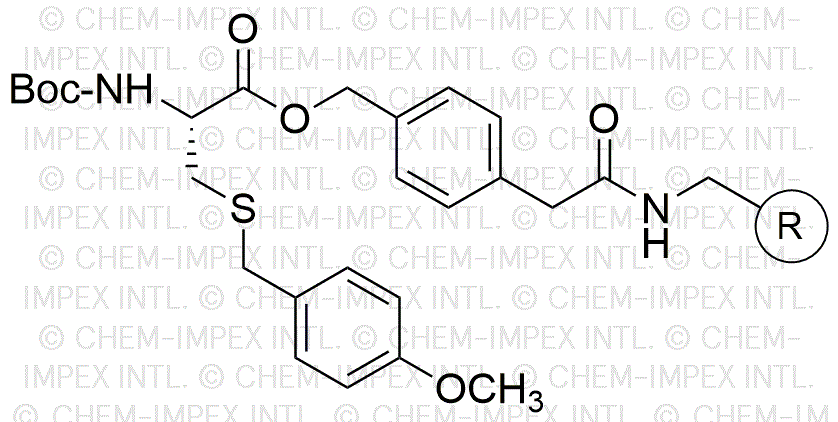Boc-S-4-methoxybenzyl-L-cysteine 4-oxymethylphenylacetamidomethyl is widely utilized in research focused on:
- Peptide Synthesis: This compound serves as a key building block in the synthesis of peptides, which are crucial for developing new drugs and therapeutic agents.
- Drug Development: It plays a significant role in the pharmaceutical industry for creating novel compounds that can target specific biological pathways, enhancing drug efficacy.
- Bioconjugation: Used in bioconjugation processes, it helps in attaching biomolecules to drugs or imaging agents, improving their delivery and effectiveness.
- Research in Cancer Therapy: This chemical is explored in studies aimed at developing targeted cancer therapies, offering potential advantages over traditional treatments.
- Antioxidant Studies: Its properties are investigated in research focused on antioxidants, contributing to the understanding of oxidative stress and related diseases.
General Information
Properties
Safety and Regulations
Applications
Boc-S-4-methoxybenzyl-L-cysteine 4-oxymethylphenylacetamidomethyl is widely utilized in research focused on:
- Peptide Synthesis: This compound serves as a key building block in the synthesis of peptides, which are crucial for developing new drugs and therapeutic agents.
- Drug Development: It plays a significant role in the pharmaceutical industry for creating novel compounds that can target specific biological pathways, enhancing drug efficacy.
- Bioconjugation: Used in bioconjugation processes, it helps in attaching biomolecules to drugs or imaging agents, improving their delivery and effectiveness.
- Research in Cancer Therapy: This chemical is explored in studies aimed at developing targeted cancer therapies, offering potential advantages over traditional treatments.
- Antioxidant Studies: Its properties are investigated in research focused on antioxidants, contributing to the understanding of oxidative stress and related diseases.
Documents
Safety Data Sheets (SDS)
The SDS provides comprehensive safety information on handling, storage, and disposal of the product.
Product Specification (PS)
The PS provides a comprehensive breakdown of the product’s properties, including chemical composition, physical state, purity, and storage requirements. It also details acceptable quality ranges and the product's intended applications.
Certificates of Analysis (COA)
Search for Certificates of Analysis (COA) by entering the products Lot Number. Lot and Batch Numbers can be found on a product’s label following the words ‘Lot’ or ‘Batch’.
Numéro de catalogue
Numéro de lot/série
Certificates Of Origin (COO)
This COO confirms the country where the product was manufactured, and also details the materials and components used in it and whether it is derived from natural, synthetic, or other specific sources. This certificate may be required for customs, trade, and regulatory compliance.
Numéro de catalogue
Numéro de lot/série
Safety Data Sheets (SDS)
The SDS provides comprehensive safety information on handling, storage, and disposal of the product.
DownloadProduct Specification (PS)
The PS provides a comprehensive breakdown of the product’s properties, including chemical composition, physical state, purity, and storage requirements. It also details acceptable quality ranges and the product's intended applications.
DownloadCertificates of Analysis (COA)
Search for Certificates of Analysis (COA) by entering the products Lot Number. Lot and Batch Numbers can be found on a product’s label following the words ‘Lot’ or ‘Batch’.
Numéro de catalogue
Numéro de lot/série
Certificates Of Origin (COO)
This COO confirms the country where the product was manufactured, and also details the materials and components used in it and whether it is derived from natural, synthetic, or other specific sources. This certificate may be required for customs, trade, and regulatory compliance.


